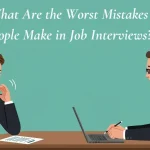Spotting Bad Employers Before You Start: Red Flags on Job Posts
Finding the right job is already tough. The last thing anyone wants is to end up working for a company that drains your energy, underpays you, or treats employees poorly. Believe it or not, many of the warning signs are hidden right in the job posting itself—you just need to know how to spot them.
A job post isn’t just about what the company wants from you. It’s also a window into their work culture, expectations, and attitude toward employees. By learning how to read between the lines, you can save yourself from wasting time, energy, and disappointment.
Let’s look at some common red flags on job posts and what they really mean.
1. Vague Job Descriptions:
A clear job post should tell you exactly what you’ll be doing day to day. If you see phrases like:
- “Various responsibilities as assigned”
- “Must be flexible with tasks”
- “We’re looking for a rockstar who can wear many hats”
…it usually means the company doesn’t have a clear idea of the role—or worse, they expect you to do everything without clear boundaries.
🔎 Why it’s a red flag: This often leads to overwork, confusion, and lack of growth.
✅ What to look for instead: Well-defined duties, specific skills, and measurable expectations.
2. Unclear or Missing Salary Information:
Job posts that avoid mentioning salary or use vague terms like:
- “Competitive pay”
- “Salary negotiable”
- “Depends on experience”
…can be a warning sign. While not all companies post exact numbers, complete secrecy often signals low or unfair pay.
🔎 Why it’s a red flag: If they aren’t transparent upfront, negotiations later may be frustrating.
✅ What to look for instead: A salary range, even if broad. It shows the company respects your time.
3. Unrealistic Requirements:
If a job description asks for:
- 3–5 years of experience for an entry-level role
- A laundry list of technical and soft skills (basically describing three different jobs in one)
- Round-the-clock availability
…it’s a sign the employer has unrealistic expectations.
🔎 Why it’s a red flag: You’ll be under constant pressure and may never feel “good enough.”
✅ What to look for instead: Reasonable requirements that match the role’s title and pay.
4. Overuse of Buzzwords:
Beware of posts filled with words like:
- “Self-starter”
- “Must thrive under pressure”
- “We work hard, play hard”
These phrases may sound exciting, but often hint at poor work-life balance, lack of support, or a chaotic environment.
🔎 Why it’s a red flag: It’s often code for long hours, high stress, and little guidance.
✅ What to look for instead: Posts that balance ambition with clear support structures.
5. Emphasis on Loyalty but Little on Benefits:
Some job ads talk endlessly about “commitment,” “dedication,” and “family-like culture,” but barely mention benefits such as health insurance, leave policies, or career growth opportunities.
🔎 Why it’s a red flag: They may expect loyalty from you without giving much in return.
✅ What to look for instead: Transparent benefits and perks listed alongside responsibilities.
6. High Pressure on Sales or Targets:
If a job description is overly focused on “meeting aggressive targets” or “unlimited earning potential,” it might be a trap. Many commission-based roles disguise unstable pay under flashy promises.
🔎 Why it’s a red flag: It often means inconsistent income, unrealistic quotas, and high turnover.
✅ What to look for instead: Clear base salary with achievable performance incentives.
7. Too Many Superlatives:
Some companies oversell themselves with phrases like:
- “The best place you’ll ever work”
- “Life-changing opportunities”
- “We’re a world-class team of superstars”
While confidence is fine, overselling often hides deeper issues.
🔎 Why it’s a red flag: Companies that truly care don’t need to exaggerate—they let their culture speak for itself.
✅ What to look for instead: Professional, straightforward descriptions that match reality.
8. Lack of Growth Opportunities:
If a job post doesn’t mention training, promotions, or learning opportunities, it could mean the role is a dead end.
🔎 Why it’s a red flag: Without career progression, you may feel stuck.
✅ What to look for instead: Clear mention of growth paths or skill development.
9. Constantly Reposted Jobs:
If you keep seeing the same job from the same company popping up every few weeks, it’s worth questioning.
🔎 Why it’s a red flag: This usually means high turnover, poor management, or unsustainable work culture.
✅ What to look for instead: Stable companies with consistent job postings, not revolving-door hiring.
10. Negative Reviews Match the Job Post:
It’s smart to cross-check the job description with company reviews on platforms like Glassdoor, Indeed, or LinkedIn. If employees complain about long hours, low pay, or poor leadership, and the job post seems vague or too good to be true, trust the reviews.
🔎 Why it’s a red flag: Where there’s smoke, there’s fire.
✅ What to look for instead: Balanced reviews with both pros and cons, which shows honesty.
How to Protect Yourself Before Applying?
- Do your homework: Research the company’s website, culture, and reviews.
- Ask questions early: If called for an interview, clarify salary, workload, and growth opportunities.
- Trust your instincts: If something feels off in the job ad, it usually is.
- Don’t rush: It’s better to apply for fewer good opportunities than to jump into a bad one.
Final Thoughts:
Job hunting can feel overwhelming, but spotting red flags early can save you from toxic work environments. Remember, a job post is a two-way street: while they’re evaluating you, you should also be evaluating them.
A great job posting should be clear, transparent, and realistic. If it feels vague, pushy, or too good to be true, take a step back and think twice.
At the end of the day, your career isn’t just about finding “a job”—it’s about finding the right job where you can grow, feel valued, and build a future.

 Previous Post
Previous Post Next Post
Next Post